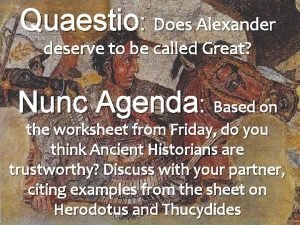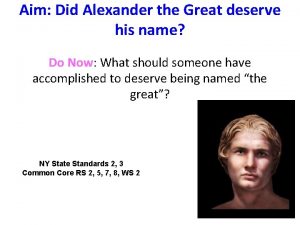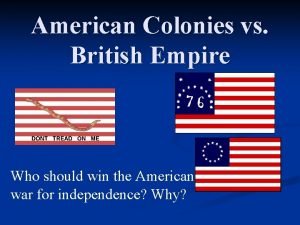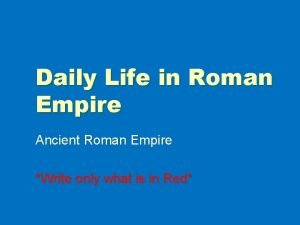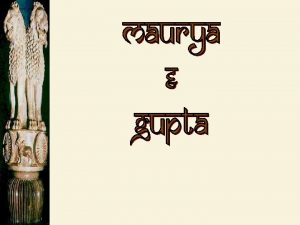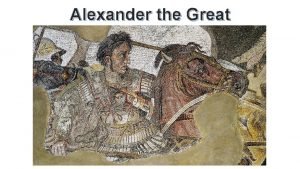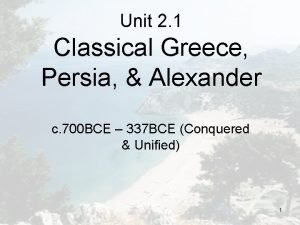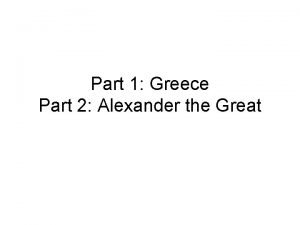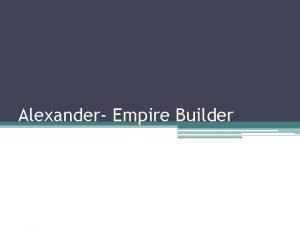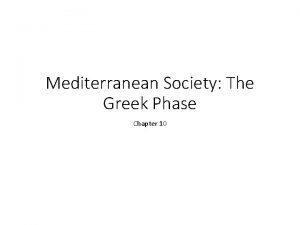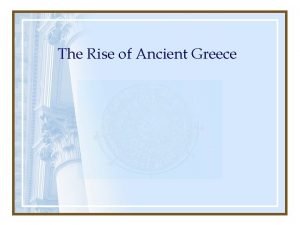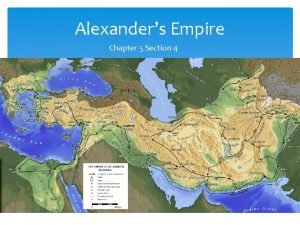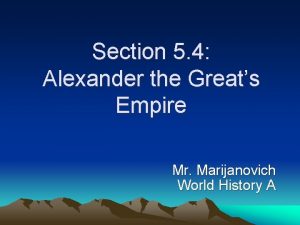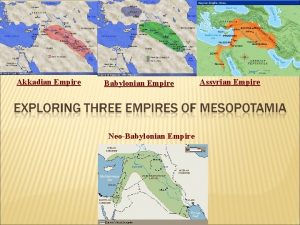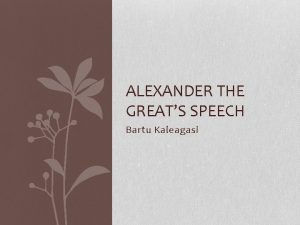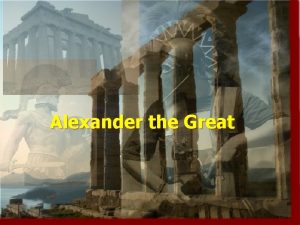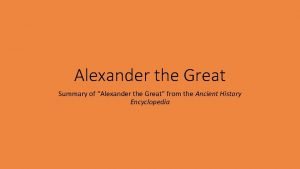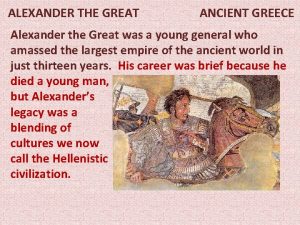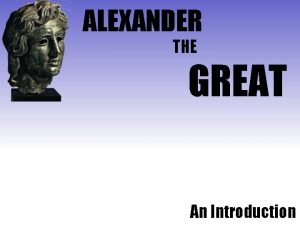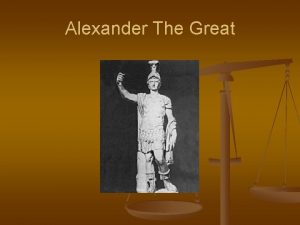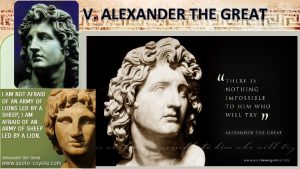Alexander the Greats Empire Alexander the Great conquers












- Slides: 12

Alexander the Great’s Empire • Alexander the Great conquers Persia and Egypt and extends his empire to the Indus River in northwest India.

Alexander’s Empire Philip Builds Macedonian Power Macedonia • Macedonia—kingdom of mountain villages north of Greece • King Philip II—ruler, brilliant general; dreams of controlling Greece • Macedonians call themselves Greek; rest of Greece does not Philip’s Army • Philip creates well-trained professional army; plans to invade Greece NEXT

• Conquest of Greece • 338 BCE - Macedonians defeat Greece; • 336 BCE - King Philip murdered • His son named king of Macedonia—becomes Alexander the Great

• Alexander’s Early Life • Story of Alexander and Bucephalus • Tutored by Aristotle; inspired by the Iliad; has military training • Becomes king when 20 years old; destroys Thebes to curb rebellion

Invasion of Persia • 334 BCE Alexander invades Persia; quick victory • Darius III—king of Persia, assembles army of 50, 000– 75, 000 men • Alexander defeats Persians again, forces King of Persia to flee

Conquering the Persian Empire • Alexander marches into Egypt, crowned pharaoh in 332 BCE • At Gaugamela in Mesopotamia, Alexander defeats Persians again • Alexander captures cities of Babylon, Susa, and Persepolis • Persepolis, the Persian capital, burned to the ground • Ashes of Persepolis signal total destruction of Persian Empire

Alexander in India • Alexander fights his way across the deserts of Central Asia to India • Alexander conquers Indus Valley area in 326 BCE • Reluctantly returns to Babylon, dies in 323 BCE

Alexander’s Legacy • Hellenistic Civilization - Alexander melds Greek and Persian cultures; wife is Persian • Empire becomes three kingdoms: (1) Macedonia, Greek city-states; (2) Egypt; (3) old Persia, also known as Seleucid kingdom

Hellenistic Culture in Alexandria • Result of Alexander’s policies—a new vibrant culture • **Hellenistic culture—Greek blended with Egyptian, Persian, Indian • Trade and Cultural Diversity • Alexandria—Egyptian city becomes center of Hellenistic civilization

Alexandria’s Attractions • Lighthouse, called the Pharos, stands over 350 feet tall • Museum contains art galleries, a zoo, botanical gardens, dining hall • Library holds masterpieces of ancient literature; supports scholars

Achievements in Science and Math • Astronomer Aristarchus proves sun is larger than Earth • Proposes planets revolve around sun; not accepted for 14 centuries • Eratosthenes uses geometry to calculate Earth’s circumference • Euclid—mathematician; Elements the basis for courses in geometry • Archimedes—scientist; ideas help build force pump and steam engine

Philosophy and Art • Stoicism and Epicureanism • Zeno founds Stoic school; promoted virtuous, simple lives • Epicurus believes people should focus on what senses perceive • Realism in Sculpture • Colossus of Rhodes— Hellenistic bronze sculpture over 100 feet tall • Sculptors move to nonclassical, natural forms; real people
 How did alexander plan to build his empire
How did alexander plan to build his empire Does alexander deserve to be called the great
Does alexander deserve to be called the great Did alexander the great deserve to be called great
Did alexander the great deserve to be called great American empire vs british empire
American empire vs british empire Rich and poor romans
Rich and poor romans Venn diagram of mauryan and gupta empires
Venn diagram of mauryan and gupta empires How many generals divided alexander's empire?
How many generals divided alexander's empire? Alexander's empire
Alexander's empire How many generals divided alexander's empire?
How many generals divided alexander's empire? Alexander empire split
Alexander empire split Alexanders empire
Alexanders empire Alexanders empire
Alexanders empire Chapter 5 section 4 alexander's empire
Chapter 5 section 4 alexander's empire

